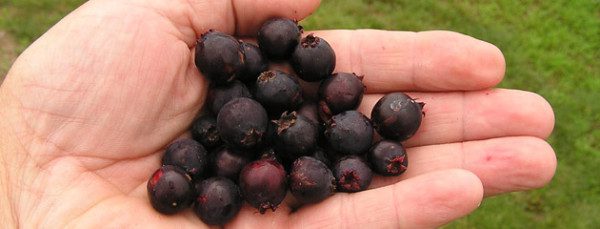

Nov 8, 2010Saskatoons an opportunity for Midwest growers
What do saskatoons and William Shatner have in common? They both originated in Canada. And like Shatner, saskatoons can be a very “enterprising” move for your farm. Will you boldly go where few growers have gone before?
Saskatoons are a member of the rose family and related to the apple, mountain ash and hawthorn. They are often compared to a blueberry, due to appearance and nutritional composition, yet it would be more accurate to think of them as a tiny apple, said Sarah Lutz of Saskatoon Project Midwest. Like an apple, saskatoons have seeds, but the seeds are eaten along with the rest of the fruit. This provides a crunchy texture, a high level of fiber and a subtle flavor that many refer to as almond-like. The skin and flesh of the saskatoon is firmer than many other berry fruits, causing the saskatoon to retain its shape when cooked. The juice of the saskatoon is somewhere between a blackberry, elderberry and blueberry.
Saskatoons are relatively new to the Midwest.
“Currently, there are about 50 acres of saskatoons planted in Michigan,” Lutz said. “Most of those plants are three to four years old. The oldest planting I know of is six years old. By next year there should be about another 50 acres planted and established, with roughly 1,000 plants per acre.”
There are 20-25 growers in Michigan that have saskatoons, Lutz said. That number is growing, thanks to the efforts of Lutz and Michigan State University Extension (MSUE). Lutz said a lot of the credit has to go to MSUE’s Steve Fouch, who has been a champion of the saskatoon. Lutz has seen a lot of growers taking small steps into berry production with 1-acre plots.
“It isn’t really known if there is going to be any diseases or pest issues with saskatoons,” Lutz said. “As of now, we haven’t had any issues and we don’t think there will be. It does make for some cautious investment into a new fruit, but so far it is going very well.”
What makes the saskatoon a good fruit for the future? Saskatoons beat out blueberries in antioxidant properties, contain important nutrients such iron and protein missing in many other berries and are lower in fat, Lutz said. The National Cancer Institute defines antioxidants as substances that may protect cells from the damage caused by unstable elements known as free radicals. Antioxidants have been found to interact with and stabilize free radicals preventing some of the damage free radicals might otherwise cause, reducing the risk of cancer, Parkinson’s disease, Alzheimer’s and combating obesity. Blueberries have long been considered a “super food” because of their high antioxidant profile.
The saskatoon was an important food source for both indigenous peoples and the early pioneers. It is also an important food source for wildlife during the winter season. It was also used as a source of wood and a medicinal plant. Today, saskatoons are used in pies, jams, jellies, syrups, ice cream toppings, wine, liqueurs and flavor concentrates and baked goods. They may be used fresh or frozen.
Saskatoon plants are hardy and can withstand cold winters and drought. They’re easily propagated, with fragrant, showy flowers, fruit and attractive fall foliage, according to Purdue University.
“Saskatoons are very cold hardy,” Lutz said. “They can withstand temps down to 70 degrees below zero, as long as the plant is established.”
Sites for growing saskatoons with late spring frosts should be avoided, according to Purdue. Saskatoons do not have high nutrition requirements, although compost worked into the soil prior to planting will help maintain soil moisture while the plant establishes. A well drained soil and a pH above 6.0 is preferred, according to Purdue.
The roots should be well covered and the soil firmed around the plant. Plants should be spaced 3 to 6 feet apart in rows, where they will grow to form a solid hedge. During the establishment year, it is important to control weeds around young plants.
“Saskatoons can be planted in either fall or spring,” Lutz said. “In fall, the plant seems to use all of its energy to establish its root system. In spring, the theory is there is less potential for winter kill, but you must plant them before the plant emerges from dormancy.”
— By Derrek Sigler, Assistant Editor














